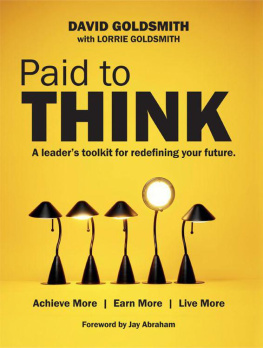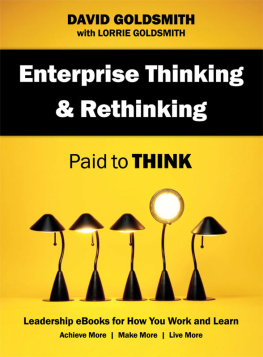
What you should know about your Paid to THINK Single
Here are a couple of tips you should know now about the Paid to THINK Single. The Paid to THINK Single is being offered to decision makers as an educational tool, designed from a long history of people seeking to use portions of content in their quests to do their jobs better. Over the years, countless leaders have received and utilized single chapters from Paid to THINK effectively to solve certain challenges and create opportunities, and now they are available to you, too.
Although each Paid to THINK Single stands on its own as a proven educational resource, be aware that within the content of certain Paid to THINK Single books, you may come across references to other Paid to THINK Singles or to the full edition of Paid to THINK. In these instances, you may want a full edition of Paid to THINK on hand to clarify terminology and concepts not fully described in this particular Paid to THINK Single.
Regardless, leaders and managers have used Paid to THINK Singles as cost-effective means of sharing information with other leaders and/or stakeholders. For instance, if you want to get six managers and 34 group members up to speed on a particular topic rapidly, you dont have to purchase 40 copies of Paid to THINK and ask everyone to read only one chapter within the larger book. Instead, you can economically teach your people by simply securing six copies of Paid to THINK for your leadership team and 34 copies of a Paid to THINK Single and achieve the same outcome!
Paid to THINK Singles offer additional value to people working in NGOs (non-governmental organizations), NPOs (non-profit organizations), and in emerging markets where the need for leadership information is great but where budgets may not be ample enough to cover pricey educational tools and methods. Luckily, Paid to THINK Single gives more people the opportunity to learn and develop..
Paid to THINK Singles make great gifts, and theyre convenient for those who dont want a full book. Whatever your purpose in choosing a Paid to THINK Single, youll find it to be an economical and easy way to learn.
This book is designed to provide accurate and authoritative information about business and leadership. Neither the author nor the publisher is engaged in rendering legal, accounting, or other professional services, by publishing this book. If any such assistance is required, the services of a qualified financial professional should be sought. The author and publisher will not be responsible for any liability, loss, or risk incurred as a result of the use and application of any information contained in this book.
This book contained single-subject material from the book Paid to THINK. Content within this Paid to THINK Single, therefore, does not necessarily cover all the terminology or descriptive material referenced within that pertains to the comprehensive resource Paid to THINK.
Copyright 2012 by David Goldsmith
All rights reserved. No part of this book may be used or reproduced in any manner whatsoever without written permission except in the case of brief quotations embodied in critical articles or reviews.

BenBella Books, Inc.
10300 N. Central Expressway, Suite 400
Dallas, TX 75231
www.benbellabooks.com
Printed in the United States of America
10 9 8 7 6 5 4 3 2 1
Library of Congress Cataloging-in-Publication Data is available for this title.
978-1-937856-46-5
Editing by Lorrie Goldsmith
Copyediting by Shannon Kelly
Proofreading by Cape Cod Compositors, Inc. and Rainbow Graphics
Indexing by Barbara Holloway, WordCo Indexing Services, Inc.
Cover design by Jelena Mirkovic
Text design and composition by Maria E. Mendez, Neuwirth & Associates, Inc.
Printed by Bang Printing
Distributed by Perseus Distribution
www.perseusdistribution.com
To place orders through Perseus Distribution:
Tel: 800-343-4499
Fax: 800-351-5073
E-mail:
CONTENTS
4
CREATING NEW PRODUCTS AND SERVICES
DAN WATSON SLID INTO THE chair behind his desk and smiled at his son, Peter, who was seated across from him. The two had come to look forward to the Tuesday morning meetings where Dan would impart nuggets of leadership wisdom to his one-day successor. For the last thirty-five years, Dan had built a multimillion-dollar die-casting business from the ground up, and he was grooming Peter to take the reins.
What can you tell me about products? Give me some examples of products, Dan began.
Peter wasnt sure where his father was going with this, since both men knew that Peter understood what a product was, but he played along, anyway. Things that go on store shelves like books and laundry detergent, as well as couches, wheel bearings, automobiles, and consumer goods.
Anything else?
Im not sure what youre asking, Peter responded.
Okay, thats fine. Dan paused for a moment and asked, Who in our company is responsible for creating new products?
Peters mind quickly scrolled through part of their employee roster, settling on the four staffers who pitch new product ideas to Dan. Rick, Patricia, Larry, and Bill, he answered with a sense of satisfaction.
Anyone else? Dan asked.
This time, Peter just looked at his father. Dan pushed his chair away from his desk, stood up, and walked to the window.
Tell me why companies create new products.
So they can stay competitive.
Right! But when you think about products, Pete, have you ever thought about internal products, like the new phone system we just got for the office? How about a new warehouse that improves operational efficiencies? Even the health insurance we offer to our employees so that theyll stay here and not go to work for a competitor across town is a product. These kinds of improvements keep us competitive too.
Ill have to think about that, Peter said. Ive never thought of them as products.
Thats okay, Pete. Most people havent. Let me put it this way. If we were to consider our internal products as well as our external products, can you think of any other people here outside of Rick, Patricia, Larry, and Bill who are responsible for product development?
I think I see where youre going with this. Youre saying that everyone here is responsible for creating new products, not just the new product development team; that is, of course, if we expand the definition of what a product is.
Dan was pleased. Peter was getting it. Thats correct. Whether were talking about phone systems in the office, health-care benefits in HR, direct-deposit payroll checks from accounting, or a standard procedure in production, everyone here is responsible for creating new products that keep us competitive.
Peter left the weekly meeting rethinking his outlook on products and how it might help him create opportunities for the organization. Instantly, he felt a renewed sense of excitement that he could provide greater value to the die-cast company, and he suspected that his coworkers would feel the same way once he shared this new perspective with them.
Like Peter, you may have previously thought of products as tangible items your organization offers to the outside world. And if your organization provides services, maybe you have considered those services to be your products. In both instances, you would be right. However, your definition wouldnt be as inclusive as it could be (or even should be) if you really want to propel your organization forward. As you read through this chapter, keep Peters lesson at the forefront of your thinking. By expanding your definition of products to include internal offerings as well as external, you open the scope of opportunities available to your organization.
Next page

















